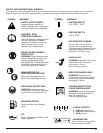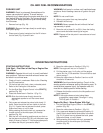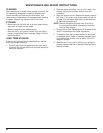
23
5. With the unit in the starting position and foot on the
wire form (Fig. 22), pull the starter rope briskly until
the engine starts.
6. When the engine starts, move the choke lever to
Position 3, and run at full throttle for 30 seconds.
NOTE: If the engine does not start using the Engine
Re-start procedures, revert to the Cold Start
procedures.
NOTE: 4-stroke engines, like cars, are able to start in
the idle position. As an alternate method, you
may want to start your unit in the idle position
when the unit is warm. With the Start/Stop
control in the START position, pull the starter
rope briskly. When the engine starts, run at full
throttle for 30 seconds. If the unit fails to start or
dies, revert to the Engine Re-Start procedure.
STOPPING INSTRUCTIONS
1. Release your hand from the throttle control (Fig. 20).
Allow the engine to idle.
2. To stop the engine, put the Start/Stop Engine
Control in the STOP [
O
] position (Fig. 20).
COLD WEATHER OPERATION
Your new 4-Cycle trimmer is shipped for operation in
conditions above 4ºC (40°F). For operation in conditions
that are below this, use the following instructions along
with your Operator's Manual. This will prepare the unit
for cold weather operation and provide improved
starting results.
WARNING: Refer to section Recommended Oil Type
and follow all warnings and safety instructions in the
operator’s manual. Failure to do so can result in
serious injury to the operator and/or bystanders.
ADDING OIL TO CRANKCASE – INITIAL USE
NOTE: This unit is shipped without oil in the crankcase.
In order to avoid damage to the unit, put oil in the
crankcase before attempting to start unit.
Your unit is supplied with one 100 ml (3.4 fl oz.) bottle of
SAE 30 SF, SG, SH oil.
For cold weather operation, temperatures below 4º C
(40°F) use a high-quality SAE 10W30 weight oil of API
(American Petroleum Institute) service class SF, SG, SH.
Follow the instructions in your Operator's Manual for
adding the correct amount of oil to this unit.
HOLDING THE TRIMMER
Before operating the unit, stand in the operating position
(Fig. 23). Check for the following:
• The operator is wearing eye protection and proper
clothing.
• Harness is adjusted to proper position.
• The handlebar is adjusted so the hands grip it without
over-extending arms.
• The unit is below waist level.
• The cutting attachment is parallel to the ground and
easily contacts the vegetation to be cut without the
operator having to bend over.
ADJUSTING TRIMMING LINE LENGTH
The Bump Head cutting attachment allows you to release
trimming line without stopping the engine. To release
more line, lightly tap the cutting attachment on the ground
(Fig. 24) while operating the trimmer at high speed.
NOTE: Always keep the trimming line fully extended.
Line release becomes more difficult as cutting
line becomes shorter.
Each time the head is bumped, about 25.4 mm (1 in.) of
trimming line is released. A blade in the cutting
attachment guard will cut the line to the proper length if
excess line is released. For best results, tap the Bump
Head on bare ground or hard soil. If line release is
attempted in tall grass, the engine may stall. Always keep
the trimming line fully extended. Line release becomes
more difficult as the cutting line becomes shorter.
NOTE: Do not rest the Bump Head on the ground.
Some line breakage will occur from:
• Entanglement with foreign matter
• Normal line fatigue
• Attempting to cut thick, stalky weeds
• Forcing the line into objects like walls or fence posts
TIPS FOR BEST TRIMMING RESULTS
• Keep the cutting attachment parallel to the ground.
• Do not force the cutting attachment. Allow the tip of
the line to do the cutting, especially along walls.
Cutting with more than the tip will reduce cutting
efficiency and may overload the engine.
• Cut grass over 200 mm (8 in.) by working from top to
bottom in small increments to avoid premature line
wear or engine drag.
• Cut from left to right whenever possible. Cutting to the
right improves the unit's cutting efficiency. Clippings
are thrown away from the operator.
• Slowly move the trimmer into and out of the cutting
area at the desired height. Move either in a forward-
backward or side-to-side motion. Cutting shorter
lengths produces the best results.
OPERATING INSTRUCTIONS


















